Monday
Aug272018
AUGUST 29, 2018
 Monday, August 27, 2018 at 09:12AM
Monday, August 27, 2018 at 09:12AM 

 From the "Greed Is Good" File. Editor-in-Chief's Note: Having observed - somewhat reluctantly - portions of the auto auction circus from Monterey, it struck me, yet again, that some of the people out there in the so-called auto "hobby" have lost their frickin' minds. I have been admonished time and again that my railings against the greed-fest that defines the auto auction game are a waste of time, because it's an inexorable part of the hobby now and there's not a damn thing that can be done about it. Perhaps that's so, but it doesn't make it right and it doesn't make it worthy of praise, either. The prices paid for some of the cars that trundled over the auction stages went beyond stupefying to just flat-out stupid. I am not going to regurgitate all of the egregious outrageousness, because it would fill up this entire issue, but in particular, the overinflated prices for recent and older "super" cars defied all rational thinking, including $467,500 for a wrecked Porsche 959. Or the six-figure prices for VW buses. Or the continued ridiculousness of air-cooled Porsche prices, including over $1 million for a 1973 Porsche 911 RS. Or, the biggest number of the weekend, $48,000,000 - including fees - for one of the original Ferrari GTOs. Now I get the fact that there were only 35 built, but what exactly does one do with a $48 million dollar Ferrari other than put it in the garage and pay insurance on it? I also get the fact that the motivation to acquire stuff when you have boatloads of cash is a powerful thing, but $48 million? C'mon, man! I now view the whole auction craze as the toxic underbelly of the car "hobby." And please spare me the argument that the auction game does so much for charity, because the auction houses use the charity angle as cover for the hyperinflated prices that they relentlessly push on people. This whole auction "thing" is going nowhere good - I've seen this movie before and it never ends well. I applaud the enthusiasts who acquire their cars for the right reasons, which is to enjoy them and drive them. The rest of what's going on is just so much unmitigated bullshit. -PMD
From the "Greed Is Good" File. Editor-in-Chief's Note: Having observed - somewhat reluctantly - portions of the auto auction circus from Monterey, it struck me, yet again, that some of the people out there in the so-called auto "hobby" have lost their frickin' minds. I have been admonished time and again that my railings against the greed-fest that defines the auto auction game are a waste of time, because it's an inexorable part of the hobby now and there's not a damn thing that can be done about it. Perhaps that's so, but it doesn't make it right and it doesn't make it worthy of praise, either. The prices paid for some of the cars that trundled over the auction stages went beyond stupefying to just flat-out stupid. I am not going to regurgitate all of the egregious outrageousness, because it would fill up this entire issue, but in particular, the overinflated prices for recent and older "super" cars defied all rational thinking, including $467,500 for a wrecked Porsche 959. Or the six-figure prices for VW buses. Or the continued ridiculousness of air-cooled Porsche prices, including over $1 million for a 1973 Porsche 911 RS. Or, the biggest number of the weekend, $48,000,000 - including fees - for one of the original Ferrari GTOs. Now I get the fact that there were only 35 built, but what exactly does one do with a $48 million dollar Ferrari other than put it in the garage and pay insurance on it? I also get the fact that the motivation to acquire stuff when you have boatloads of cash is a powerful thing, but $48 million? C'mon, man! I now view the whole auction craze as the toxic underbelly of the car "hobby." And please spare me the argument that the auction game does so much for charity, because the auction houses use the charity angle as cover for the hyperinflated prices that they relentlessly push on people. This whole auction "thing" is going nowhere good - I've seen this movie before and it never ends well. I applaud the enthusiasts who acquire their cars for the right reasons, which is to enjoy them and drive them. The rest of what's going on is just so much unmitigated bullshit. -PMD
(Mercedes-Benz images)
Mercedes-Benz has unveiled the EQ Silver Arrow show car at Monterey Car Week. An homage to the successful record-breaking Mercedes-Benz W 125 car from 1937, the one-seater EQ Silver Arrow glistens in its Alubeam Silver paintwork, which is reminiscent of the historic Silver Arrows, which, for weight reasons, did not have a white paint layer. "Over 80 years ago, the historic Silver Arrows demonstrated that Mercedes-Benz was a pioneer when it came to speed, thanks, among other things, to their streamlined shape," says Gorden Wagener, Chief Design Officer at Daimler AG. "The EQ Silver Arrow show car draws on that legacy. Intended for acceleration and driving pleasure, it embodies progressive luxury and provides an insight into the future of our design. As a result, the show car drives the design idiom of our new EQ product and technology brand to the top." Mercedes-Benz PR minions chimed in with this: "EQ brand is shaped by the avant-garde, distinct aesthetic of Progressive Luxury, which arises from the combination of a previously unknown beauty, the conscious clash of digital and analogue elements, as well as the seamless merging of intuitive and physical design."
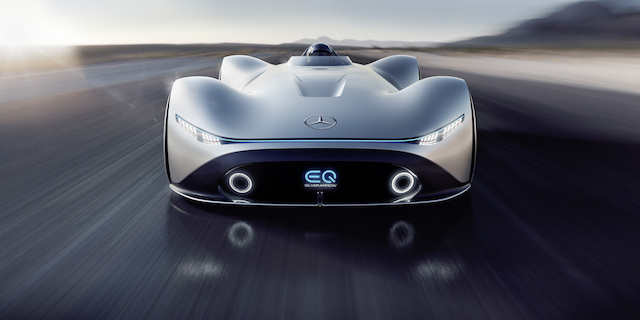 The EQ Silver Arrow's streamlined silhouette is 5.3-meters long and its body structure is made of carbon fiber. The multiple layers of paintwork in Alubeam Silver are designed to appear like liquid metal on the surface. Other exterior highlights include the driver's cockpit, which can be folded forward, and the partially free-standing multi-spoke wheels. The non-rotating hub caps and the partial trim on the wheels are other stylish highlights. The 168 spokes per wheel are made of lightweight aluminum and painted a rose gold color, which is also a signature of the EQ brand. The EQ Silver Arrow has slick 255/25 R 24 tires at the front and 305/25 R 26 tires at the rear. Pirelli embossed a star pattern on the tread. The rear diffuser has two extendible rear spoilers that act as an air brake by increasing the wind resistance when deceleration is desired.
The EQ Silver Arrow's streamlined silhouette is 5.3-meters long and its body structure is made of carbon fiber. The multiple layers of paintwork in Alubeam Silver are designed to appear like liquid metal on the surface. Other exterior highlights include the driver's cockpit, which can be folded forward, and the partially free-standing multi-spoke wheels. The non-rotating hub caps and the partial trim on the wheels are other stylish highlights. The 168 spokes per wheel are made of lightweight aluminum and painted a rose gold color, which is also a signature of the EQ brand. The EQ Silver Arrow has slick 255/25 R 24 tires at the front and 305/25 R 26 tires at the rear. Pirelli embossed a star pattern on the tread. The rear diffuser has two extendible rear spoilers that act as an air brake by increasing the wind resistance when deceleration is desired.
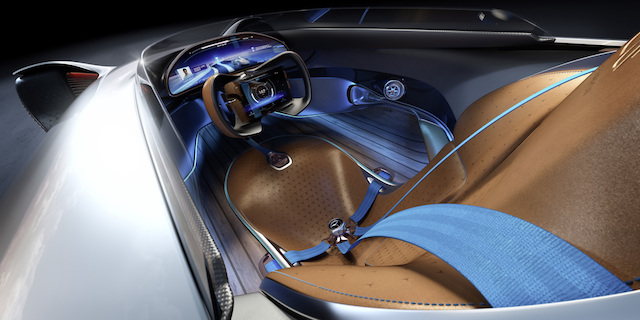 The interior of the EQ Silver Arrow is one of contrasts. On the one hand, it uses traditional, high-quality materials like Saddle Brown genuine leather on the seat and steering wheel, brushed aluminum throughout the interior and solid walnut with darker coniferous wood pinstripes on the floor. On the other hand, modern, high-tech features such as the large projection surface for the panoramic screen and innovative user experience solutions such as the virtual race option represent the EQ's visionary character. The seat surface and backrest have a unique pattern aligned with the seat contour; stars are etched with laser engraving. AIRSCARF neck-level heating is integrated into the seat and it is equipped with a four-point seatbelt. The pedals can be adapted to the driver's specific stature, with a controller located on the seat for adjusting the pedals. To match the exterior paint finish in Alubeam Silver, the side walls of the interior are covered in a luxurious, grey suede.
The interior of the EQ Silver Arrow is one of contrasts. On the one hand, it uses traditional, high-quality materials like Saddle Brown genuine leather on the seat and steering wheel, brushed aluminum throughout the interior and solid walnut with darker coniferous wood pinstripes on the floor. On the other hand, modern, high-tech features such as the large projection surface for the panoramic screen and innovative user experience solutions such as the virtual race option represent the EQ's visionary character. The seat surface and backrest have a unique pattern aligned with the seat contour; stars are etched with laser engraving. AIRSCARF neck-level heating is integrated into the seat and it is equipped with a four-point seatbelt. The pedals can be adapted to the driver's specific stature, with a controller located on the seat for adjusting the pedals. To match the exterior paint finish in Alubeam Silver, the side walls of the interior are covered in a luxurious, grey suede.
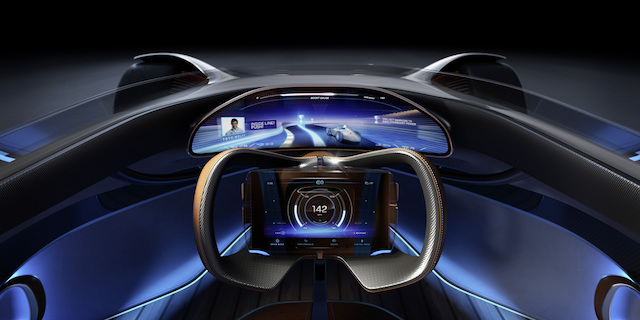 The driver of the EQ Silver Arrow is encompassed by a large panoramic screen on which a 3D image of the surroundings is projected from behind. As an indicator of future possible charging technologies, the lane of the roadway on which inductive charging is possible is superimposed onto the screen. This is where it gets crazy: "With the help of artificial intelligence, it is possible to engage in a virtual race against historic or present Silver Arrow racing cars. A virtual racetrack is superimposed onto the real roadway via the panoramic screen and the driver sees their opponent either ahead of them or behind them as a 'ghost.' The Virtual Race Coach assistance function helps one improve driving skills by giving instructions during the race," according to Mercedes-Benz. Uh, alrighty then. The driver can use the touchscreen on the steering wheel to select programs such as Comfort, Sport and Sport+, which offer different driving characteristics. Sound settings can also be configured here: choices include the sound of a current Formula 1 Silver Arrow or a Mercedes-AMG V8 engine.
The driver of the EQ Silver Arrow is encompassed by a large panoramic screen on which a 3D image of the surroundings is projected from behind. As an indicator of future possible charging technologies, the lane of the roadway on which inductive charging is possible is superimposed onto the screen. This is where it gets crazy: "With the help of artificial intelligence, it is possible to engage in a virtual race against historic or present Silver Arrow racing cars. A virtual racetrack is superimposed onto the real roadway via the panoramic screen and the driver sees their opponent either ahead of them or behind them as a 'ghost.' The Virtual Race Coach assistance function helps one improve driving skills by giving instructions during the race," according to Mercedes-Benz. Uh, alrighty then. The driver can use the touchscreen on the steering wheel to select programs such as Comfort, Sport and Sport+, which offer different driving characteristics. Sound settings can also be configured here: choices include the sound of a current Formula 1 Silver Arrow or a Mercedes-AMG V8 engine.
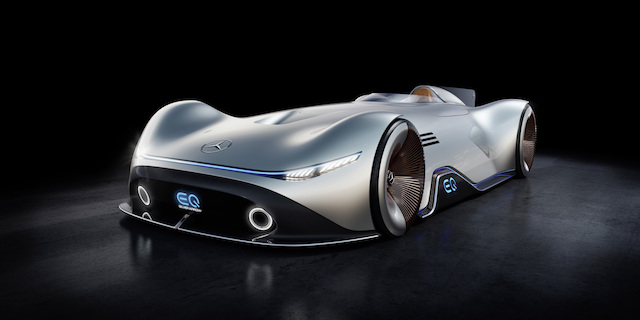 The EQ Silver Arrow is conceived as an electric vehicle with an output of 738 hp. The thin rechargeable battery in the underbody has a usable capacity of approximately 80 kWh and enables an approximate range of over 250 miles. Side air vents help to cool the battery.
The EQ Silver Arrow is conceived as an electric vehicle with an output of 738 hp. The thin rechargeable battery in the underbody has a usable capacity of approximately 80 kWh and enables an approximate range of over 250 miles. Side air vents help to cool the battery.
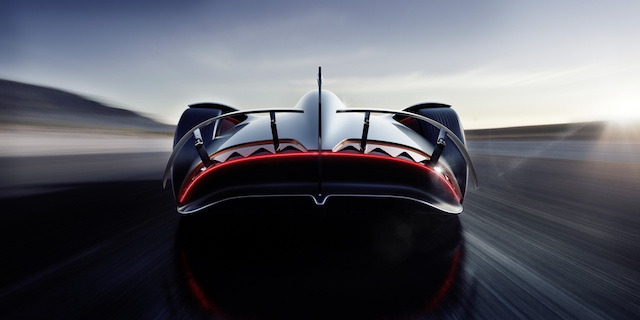
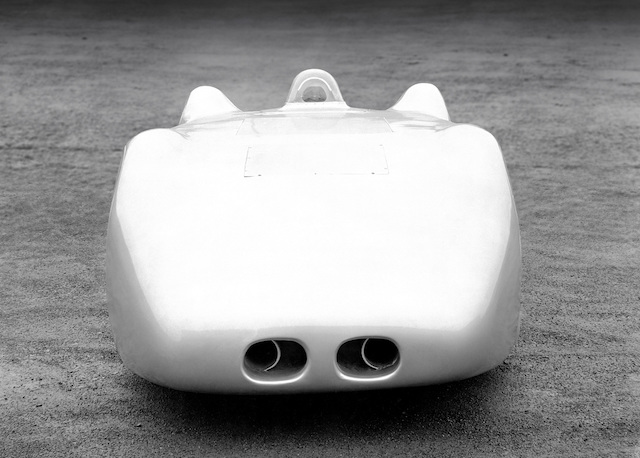 The 1937 Mercedes-Benz W 125 streamliner record car from 1937.
The 1937 Mercedes-Benz W 125 streamliner record car from 1937.
Mercedes-Benz has unveiled the EQ Silver Arrow show car at Monterey Car Week. An homage to the successful record-breaking Mercedes-Benz W 125 car from 1937, the one-seater EQ Silver Arrow glistens in its Alubeam Silver paintwork, which is reminiscent of the historic Silver Arrows, which, for weight reasons, did not have a white paint layer. "Over 80 years ago, the historic Silver Arrows demonstrated that Mercedes-Benz was a pioneer when it came to speed, thanks, among other things, to their streamlined shape," says Gorden Wagener, Chief Design Officer at Daimler AG. "The EQ Silver Arrow show car draws on that legacy. Intended for acceleration and driving pleasure, it embodies progressive luxury and provides an insight into the future of our design. As a result, the show car drives the design idiom of our new EQ product and technology brand to the top." Mercedes-Benz PR minions chimed in with this: "EQ brand is shaped by the avant-garde, distinct aesthetic of Progressive Luxury, which arises from the combination of a previously unknown beauty, the conscious clash of digital and analogue elements, as well as the seamless merging of intuitive and physical design."
 The EQ Silver Arrow's streamlined silhouette is 5.3-meters long and its body structure is made of carbon fiber. The multiple layers of paintwork in Alubeam Silver are designed to appear like liquid metal on the surface. Other exterior highlights include the driver's cockpit, which can be folded forward, and the partially free-standing multi-spoke wheels. The non-rotating hub caps and the partial trim on the wheels are other stylish highlights. The 168 spokes per wheel are made of lightweight aluminum and painted a rose gold color, which is also a signature of the EQ brand. The EQ Silver Arrow has slick 255/25 R 24 tires at the front and 305/25 R 26 tires at the rear. Pirelli embossed a star pattern on the tread. The rear diffuser has two extendible rear spoilers that act as an air brake by increasing the wind resistance when deceleration is desired.
The EQ Silver Arrow's streamlined silhouette is 5.3-meters long and its body structure is made of carbon fiber. The multiple layers of paintwork in Alubeam Silver are designed to appear like liquid metal on the surface. Other exterior highlights include the driver's cockpit, which can be folded forward, and the partially free-standing multi-spoke wheels. The non-rotating hub caps and the partial trim on the wheels are other stylish highlights. The 168 spokes per wheel are made of lightweight aluminum and painted a rose gold color, which is also a signature of the EQ brand. The EQ Silver Arrow has slick 255/25 R 24 tires at the front and 305/25 R 26 tires at the rear. Pirelli embossed a star pattern on the tread. The rear diffuser has two extendible rear spoilers that act as an air brake by increasing the wind resistance when deceleration is desired. The interior of the EQ Silver Arrow is one of contrasts. On the one hand, it uses traditional, high-quality materials like Saddle Brown genuine leather on the seat and steering wheel, brushed aluminum throughout the interior and solid walnut with darker coniferous wood pinstripes on the floor. On the other hand, modern, high-tech features such as the large projection surface for the panoramic screen and innovative user experience solutions such as the virtual race option represent the EQ's visionary character. The seat surface and backrest have a unique pattern aligned with the seat contour; stars are etched with laser engraving. AIRSCARF neck-level heating is integrated into the seat and it is equipped with a four-point seatbelt. The pedals can be adapted to the driver's specific stature, with a controller located on the seat for adjusting the pedals. To match the exterior paint finish in Alubeam Silver, the side walls of the interior are covered in a luxurious, grey suede.
The interior of the EQ Silver Arrow is one of contrasts. On the one hand, it uses traditional, high-quality materials like Saddle Brown genuine leather on the seat and steering wheel, brushed aluminum throughout the interior and solid walnut with darker coniferous wood pinstripes on the floor. On the other hand, modern, high-tech features such as the large projection surface for the panoramic screen and innovative user experience solutions such as the virtual race option represent the EQ's visionary character. The seat surface and backrest have a unique pattern aligned with the seat contour; stars are etched with laser engraving. AIRSCARF neck-level heating is integrated into the seat and it is equipped with a four-point seatbelt. The pedals can be adapted to the driver's specific stature, with a controller located on the seat for adjusting the pedals. To match the exterior paint finish in Alubeam Silver, the side walls of the interior are covered in a luxurious, grey suede. The driver of the EQ Silver Arrow is encompassed by a large panoramic screen on which a 3D image of the surroundings is projected from behind. As an indicator of future possible charging technologies, the lane of the roadway on which inductive charging is possible is superimposed onto the screen. This is where it gets crazy: "With the help of artificial intelligence, it is possible to engage in a virtual race against historic or present Silver Arrow racing cars. A virtual racetrack is superimposed onto the real roadway via the panoramic screen and the driver sees their opponent either ahead of them or behind them as a 'ghost.' The Virtual Race Coach assistance function helps one improve driving skills by giving instructions during the race," according to Mercedes-Benz. Uh, alrighty then. The driver can use the touchscreen on the steering wheel to select programs such as Comfort, Sport and Sport+, which offer different driving characteristics. Sound settings can also be configured here: choices include the sound of a current Formula 1 Silver Arrow or a Mercedes-AMG V8 engine.
The driver of the EQ Silver Arrow is encompassed by a large panoramic screen on which a 3D image of the surroundings is projected from behind. As an indicator of future possible charging technologies, the lane of the roadway on which inductive charging is possible is superimposed onto the screen. This is where it gets crazy: "With the help of artificial intelligence, it is possible to engage in a virtual race against historic or present Silver Arrow racing cars. A virtual racetrack is superimposed onto the real roadway via the panoramic screen and the driver sees their opponent either ahead of them or behind them as a 'ghost.' The Virtual Race Coach assistance function helps one improve driving skills by giving instructions during the race," according to Mercedes-Benz. Uh, alrighty then. The driver can use the touchscreen on the steering wheel to select programs such as Comfort, Sport and Sport+, which offer different driving characteristics. Sound settings can also be configured here: choices include the sound of a current Formula 1 Silver Arrow or a Mercedes-AMG V8 engine. The EQ Silver Arrow is conceived as an electric vehicle with an output of 738 hp. The thin rechargeable battery in the underbody has a usable capacity of approximately 80 kWh and enables an approximate range of over 250 miles. Side air vents help to cool the battery.
The EQ Silver Arrow is conceived as an electric vehicle with an output of 738 hp. The thin rechargeable battery in the underbody has a usable capacity of approximately 80 kWh and enables an approximate range of over 250 miles. Side air vents help to cool the battery.
 The 1937 Mercedes-Benz W 125 streamliner record car from 1937.
The 1937 Mercedes-Benz W 125 streamliner record car from 1937.Our AE Quote of the Week goes to Mike Flewitt, the CEO of McLaren, who was interviewed at the Goodwood Festival of Speed by Automotive News. AN: Lamborghini has entered the white-hot crossover/SUV market. Why is McLaren against going down that path? Flewitt: "I'm not against SUVs. They are just not what McLaren does. An SUV is hugely expensive to do. We wouldn't have the shared engineering that you need to have the kind of business model that supports what we do. When we decide to do a product there are three simple tests: It has to be right for the brand and right for the customer base, we've got to have the technology to do the best car in class and we've got to make money. An SUV starts to reduce the purity of the brand as a supercar driver's brand. Secondly, we don't have the technology. Can you imagine from a standing start if we wanted to go out and do a better car than a Range Rover, or a Cayenne — the billions we'd have to invest? Third, therefore, is we wouldn't make any money. So it doesn't tick any box." Editor-in-Chief's Note: As I've said repeatedly, before you can manage a brand you have to understand what it isn't before you can understand what it is. Kudos to Mr. Flewitt for understanding that. -PMD
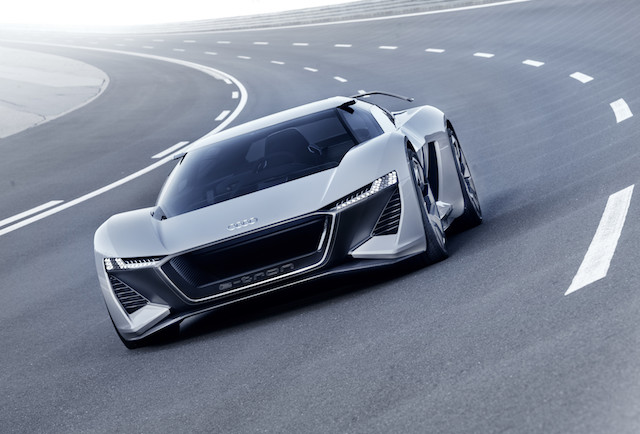
(Audi images)
Audi is presenting a design and technical concept car at Pebble Beach Automotive Week in Monterey, California, for the first time. The all-electric Audi PB18 e-tron "presents a radical vision for the high-performance sports car of tomorrow," according to Audi PR minions. The concept was created in the new Audi design studio in Malibu, California – where the brand’s design is consistently being updated for the future. The technical concept of the PB18 e-tron is clearly a direct link to Audi's most recent Le Mans-winning racing car, the Audi R18 e-tron. The abbreviated name “PB18 e-tron” refers both to the Pebble Beach venue for the premiere and to the technological DNA it shares with the Audi R18 e-tron. Audi Sport GmbH, the high-performance subsidiary of Audi, was responsible for implementation. The PB18 e-tron was designed to be a radical driving machine for the racetrack and road. Parameters like propulsive power, lateral acceleration and perfect ergonomics determined each detail. And driver-orientation is in a completely new dimension. The internal working title at Audi for the showcar project was “Level Zero” – as an explicit way to differentiate it from the Levels 3, 4 and 5 of autonomous driving currently in focus at Audi. In the Audi PB18 e-tron, the driver is the one steering and stepping on the gas or brake pedal (hallefrickin'luja -PMD).
 No complex systems for piloted driving are on board and no comfort features to add weight. In their place are a driver’s seat and cockpit that are integrated into an inner monocoque shell that can be slid laterally. When driven solo, the monocoque can be positioned in the center of the interior as in a monoposto – the perfect location for the racetrack. This is made possible by the by-wire design of the steering and pedals, since a mechanical connection of the control elements is not needed. Gael Buzyn, Head of the Audi Design Loft in Malibu where the Audi PB18 e-tron was born, describes the car: “We want to offer the driver an experience that is otherwise available only in a racing car like the Audi R18. That’s why we developed the interior around the ideal driver’s position in the center. Nevertheless, our aim was to also give the PB18 e-tron a high degree of everyday usability, not just for the driver, but also for a potential passenger.” When the driver’s monocoque is slid into the side position, from where the PB18 e-tron can be steered in everyday driving like a conventional road vehicle, there is room for a passenger. An additional seat can be accessed on the other side, integrated low above the ground and equipped with a three-point seat belt. The driver also benefits when getting in and out from the easily accessible outside position of the monocoque, which can be moved when the door is open up to the sill.
No complex systems for piloted driving are on board and no comfort features to add weight. In their place are a driver’s seat and cockpit that are integrated into an inner monocoque shell that can be slid laterally. When driven solo, the monocoque can be positioned in the center of the interior as in a monoposto – the perfect location for the racetrack. This is made possible by the by-wire design of the steering and pedals, since a mechanical connection of the control elements is not needed. Gael Buzyn, Head of the Audi Design Loft in Malibu where the Audi PB18 e-tron was born, describes the car: “We want to offer the driver an experience that is otherwise available only in a racing car like the Audi R18. That’s why we developed the interior around the ideal driver’s position in the center. Nevertheless, our aim was to also give the PB18 e-tron a high degree of everyday usability, not just for the driver, but also for a potential passenger.” When the driver’s monocoque is slid into the side position, from where the PB18 e-tron can be steered in everyday driving like a conventional road vehicle, there is room for a passenger. An additional seat can be accessed on the other side, integrated low above the ground and equipped with a three-point seat belt. The driver also benefits when getting in and out from the easily accessible outside position of the monocoque, which can be moved when the door is open up to the sill.
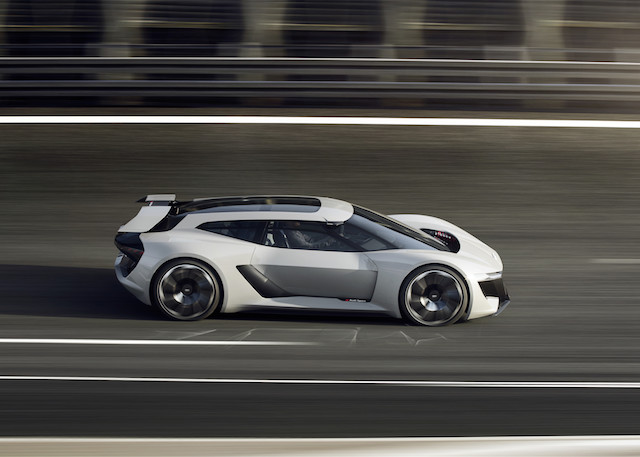 A mix of aluminum, carbon and multi-material composites and an innovative and comparatively light solid-state battery delivers a low total weight of less than 1,550 kg (3,417.2 lbs). The PB18 e-tron is 4.53 meters long, 2 meters wide and just 1.15 meters tall (14.5 x 6.4 x 4.6 ft). The wheelbase is 2.70 meters (8.9 ft). The concept uses three powerful electric motors – one up front and two in the rear. The latter are centrally located between the steering knuckles, each directly driving one wheel via half-shafts. They deliver power output of up to 150 kW to the front axle and 350 kW to the rear – the Audi PB18 e-tron is a true quattro, of course. Maximum output is 500 kW, with boosting, the driver can temporarily mobilize up to 570 kW. The combined torque of up to 830 newton meters (612.2 lb-ft) allows acceleration from 0 to 100 km/h (62.1 mph) in scarcely more than 2 seconds – a speed that differs only marginally from that of a current LMP1 prototype.
A mix of aluminum, carbon and multi-material composites and an innovative and comparatively light solid-state battery delivers a low total weight of less than 1,550 kg (3,417.2 lbs). The PB18 e-tron is 4.53 meters long, 2 meters wide and just 1.15 meters tall (14.5 x 6.4 x 4.6 ft). The wheelbase is 2.70 meters (8.9 ft). The concept uses three powerful electric motors – one up front and two in the rear. The latter are centrally located between the steering knuckles, each directly driving one wheel via half-shafts. They deliver power output of up to 150 kW to the front axle and 350 kW to the rear – the Audi PB18 e-tron is a true quattro, of course. Maximum output is 500 kW, with boosting, the driver can temporarily mobilize up to 570 kW. The combined torque of up to 830 newton meters (612.2 lb-ft) allows acceleration from 0 to 100 km/h (62.1 mph) in scarcely more than 2 seconds – a speed that differs only marginally from that of a current LMP1 prototype.
 No complex systems for piloted driving are on board and no comfort features to add weight. In their place are a driver’s seat and cockpit that are integrated into an inner monocoque shell that can be slid laterally. When driven solo, the monocoque can be positioned in the center of the interior as in a monoposto – the perfect location for the racetrack. This is made possible by the by-wire design of the steering and pedals, since a mechanical connection of the control elements is not needed. Gael Buzyn, Head of the Audi Design Loft in Malibu where the Audi PB18 e-tron was born, describes the car: “We want to offer the driver an experience that is otherwise available only in a racing car like the Audi R18. That’s why we developed the interior around the ideal driver’s position in the center. Nevertheless, our aim was to also give the PB18 e-tron a high degree of everyday usability, not just for the driver, but also for a potential passenger.” When the driver’s monocoque is slid into the side position, from where the PB18 e-tron can be steered in everyday driving like a conventional road vehicle, there is room for a passenger. An additional seat can be accessed on the other side, integrated low above the ground and equipped with a three-point seat belt. The driver also benefits when getting in and out from the easily accessible outside position of the monocoque, which can be moved when the door is open up to the sill.
No complex systems for piloted driving are on board and no comfort features to add weight. In their place are a driver’s seat and cockpit that are integrated into an inner monocoque shell that can be slid laterally. When driven solo, the monocoque can be positioned in the center of the interior as in a monoposto – the perfect location for the racetrack. This is made possible by the by-wire design of the steering and pedals, since a mechanical connection of the control elements is not needed. Gael Buzyn, Head of the Audi Design Loft in Malibu where the Audi PB18 e-tron was born, describes the car: “We want to offer the driver an experience that is otherwise available only in a racing car like the Audi R18. That’s why we developed the interior around the ideal driver’s position in the center. Nevertheless, our aim was to also give the PB18 e-tron a high degree of everyday usability, not just for the driver, but also for a potential passenger.” When the driver’s monocoque is slid into the side position, from where the PB18 e-tron can be steered in everyday driving like a conventional road vehicle, there is room for a passenger. An additional seat can be accessed on the other side, integrated low above the ground and equipped with a three-point seat belt. The driver also benefits when getting in and out from the easily accessible outside position of the monocoque, which can be moved when the door is open up to the sill.  A mix of aluminum, carbon and multi-material composites and an innovative and comparatively light solid-state battery delivers a low total weight of less than 1,550 kg (3,417.2 lbs). The PB18 e-tron is 4.53 meters long, 2 meters wide and just 1.15 meters tall (14.5 x 6.4 x 4.6 ft). The wheelbase is 2.70 meters (8.9 ft). The concept uses three powerful electric motors – one up front and two in the rear. The latter are centrally located between the steering knuckles, each directly driving one wheel via half-shafts. They deliver power output of up to 150 kW to the front axle and 350 kW to the rear – the Audi PB18 e-tron is a true quattro, of course. Maximum output is 500 kW, with boosting, the driver can temporarily mobilize up to 570 kW. The combined torque of up to 830 newton meters (612.2 lb-ft) allows acceleration from 0 to 100 km/h (62.1 mph) in scarcely more than 2 seconds – a speed that differs only marginally from that of a current LMP1 prototype.
A mix of aluminum, carbon and multi-material composites and an innovative and comparatively light solid-state battery delivers a low total weight of less than 1,550 kg (3,417.2 lbs). The PB18 e-tron is 4.53 meters long, 2 meters wide and just 1.15 meters tall (14.5 x 6.4 x 4.6 ft). The wheelbase is 2.70 meters (8.9 ft). The concept uses three powerful electric motors – one up front and two in the rear. The latter are centrally located between the steering knuckles, each directly driving one wheel via half-shafts. They deliver power output of up to 150 kW to the front axle and 350 kW to the rear – the Audi PB18 e-tron is a true quattro, of course. Maximum output is 500 kW, with boosting, the driver can temporarily mobilize up to 570 kW. The combined torque of up to 830 newton meters (612.2 lb-ft) allows acceleration from 0 to 100 km/h (62.1 mph) in scarcely more than 2 seconds – a speed that differs only marginally from that of a current LMP1 prototype.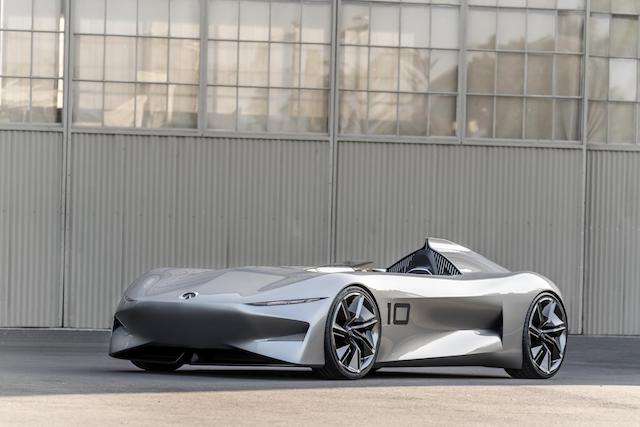
(Infiniti images)
Editor-in-Chief's Note: Monterey Car Week has become the showcase of "Swingin' Dickism" as the auto manufacturers all line up to display their - ahem - wares. From the calculated greed fest on display at the various auctions, to the wildly extravagant manufacturer pavilions, Monterey Car Week is the pinnacle of over-the-top automotive excess that has become almost beyond comprehension at this point. The first factory entry for your viewing pleasure this week is the INFINITI Prototype 10 - which the company's PR minions framed this way: "Bridging past and future, the INFINITI Prototype 10 recaptures the spirit of early speedsters for an era of electrified performance... The Prototype 10 provides a window into INFINITI's desire to deliver driving pleasure, thrilling performance and range confidence." The Prototype 10 was overseen by INFINITI's Japan design center, designed digitally in the U.K., and then crafted by hand in San Diego, California. Karim Habib, Executive Design Director, INFINITI, had this to say: "The INFINITI Prototype 10 echoes the layout and design of early speedsters. This period saw the creation of some of the most evocative car designs of all time, where power was celebrated through high-powered single-seat competition cars. Our new concept speaks of an electrified future, something which is reflected in its form and details. It is appropriate that we found inspiration in an optimistic bygone era in which cars were characterized by the simple love of driving." Ironic, isn't it? Since the anti-auto zealots are pushing the notion that driving will become passe. Kudos to INFINITI for doing a concept that has nothing to do with nothin', but is just nice to look at (unlike the Protoype 9 from last year, which was a giant beat-off). -PMD
Editor-in-Chief's Note: Monterey Car Week has become the showcase of "Swingin' Dickism" as the auto manufacturers all line up to display their - ahem - wares. From the calculated greed fest on display at the various auctions, to the wildly extravagant manufacturer pavilions, Monterey Car Week is the pinnacle of over-the-top automotive excess that has become almost beyond comprehension at this point. The first factory entry for your viewing pleasure this week is the INFINITI Prototype 10 - which the company's PR minions framed this way: "Bridging past and future, the INFINITI Prototype 10 recaptures the spirit of early speedsters for an era of electrified performance... The Prototype 10 provides a window into INFINITI's desire to deliver driving pleasure, thrilling performance and range confidence." The Prototype 10 was overseen by INFINITI's Japan design center, designed digitally in the U.K., and then crafted by hand in San Diego, California. Karim Habib, Executive Design Director, INFINITI, had this to say: "The INFINITI Prototype 10 echoes the layout and design of early speedsters. This period saw the creation of some of the most evocative car designs of all time, where power was celebrated through high-powered single-seat competition cars. Our new concept speaks of an electrified future, something which is reflected in its form and details. It is appropriate that we found inspiration in an optimistic bygone era in which cars were characterized by the simple love of driving." Ironic, isn't it? Since the anti-auto zealots are pushing the notion that driving will become passe. Kudos to INFINITI for doing a concept that has nothing to do with nothin', but is just nice to look at (unlike the Protoype 9 from last year, which was a giant beat-off). -PMD
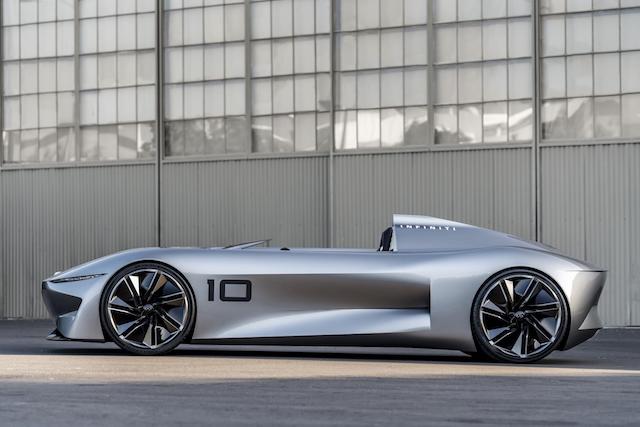
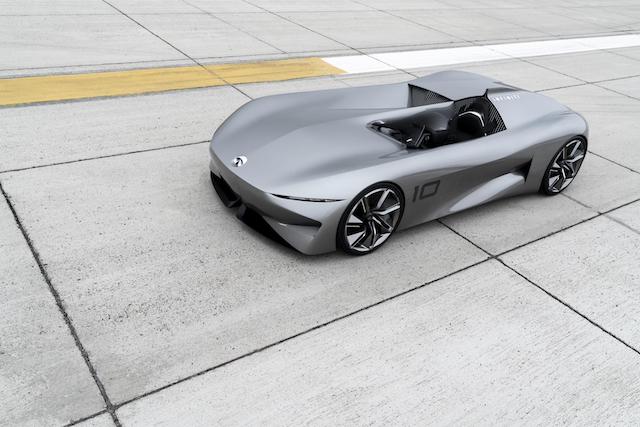
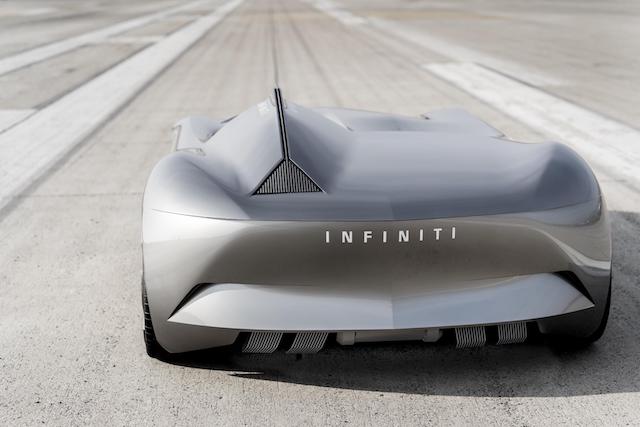
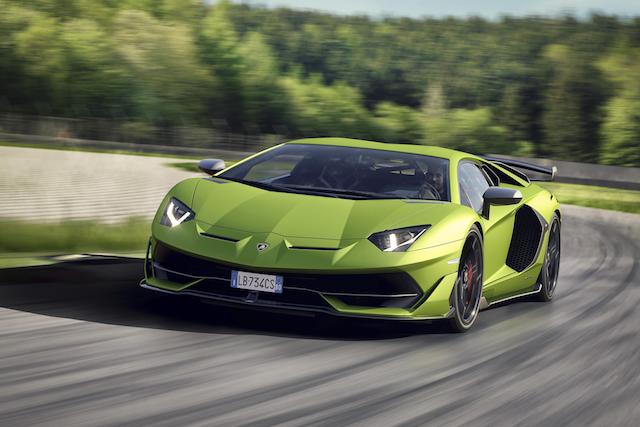
(Lamborghini images)
Lamborghini has introduced the Adventador SVJ, a new generation of its V12 flagship. The high-performance machine features advance aerodynamics, lightweight materials, four-wheel drive, four-wheel steering and a naturally-aspirated V12 with 770HP. Performance? 0-100km/h in 2.8 seconds with a top speed over 350 km/h. The Adventador SVJ lapped the Nürburgring-Nordschleife at 6:44.97 minutes, which is a lap record for production cars. The price when it arrives in the U.S. is $517,770.00 (Gas Guzzler Tax Included), and it will be limited to 900 units globally.
Lamborghini has introduced the Adventador SVJ, a new generation of its V12 flagship. The high-performance machine features advance aerodynamics, lightweight materials, four-wheel drive, four-wheel steering and a naturally-aspirated V12 with 770HP. Performance? 0-100km/h in 2.8 seconds with a top speed over 350 km/h. The Adventador SVJ lapped the Nürburgring-Nordschleife at 6:44.97 minutes, which is a lap record for production cars. The price when it arrives in the U.S. is $517,770.00 (Gas Guzzler Tax Included), and it will be limited to 900 units globally.
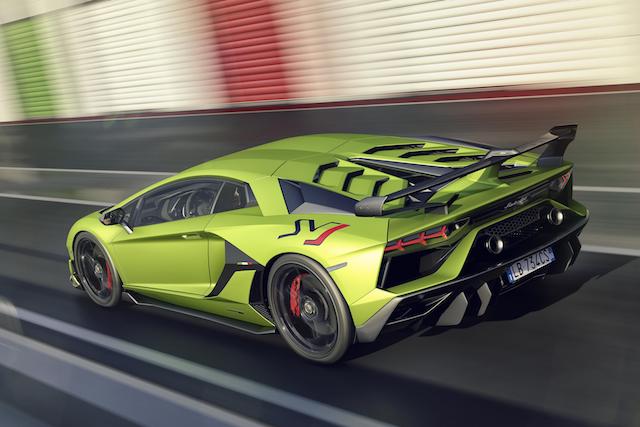

(Acura)
Acura has updated its 2019 Acura NSX with new design cues and fresh colors, including a Thermal Orange Pearl, and Indigo blue and full Red leather options for the interior. More important, the 2019 NSX gets stiffer stabilizer bars, a grippier tire and software tuning designed to elevate performance in all driving situations — whether on the street or race track. The result, according to Honda, is a nearly 2-second faster lap time around the legendary Suzuka Circuit. Acura calls the 2019 NSX "the only supercar made in America (we're quite sure Corvette operatives would beg to differ -WG) and the only one utilizing electric motors to enhance all aspects of dynamic performance." The NSX has a twin-turbocharged mid‑mounted V6 engine paired with a 9-speed dual clutch transmission (9DCT) and integrated electric Direct Drive Motor and a torque-vectoring Twin Motor Unit at the front axle. The 2019 NSX is available for order today, with U.S. deliveries slated to begin in October. The NSX is produced at the bespoke Performance Manufacturing Center (PMC) in Marysville, Ohio.
Acura has updated its 2019 Acura NSX with new design cues and fresh colors, including a Thermal Orange Pearl, and Indigo blue and full Red leather options for the interior. More important, the 2019 NSX gets stiffer stabilizer bars, a grippier tire and software tuning designed to elevate performance in all driving situations — whether on the street or race track. The result, according to Honda, is a nearly 2-second faster lap time around the legendary Suzuka Circuit. Acura calls the 2019 NSX "the only supercar made in America (we're quite sure Corvette operatives would beg to differ -WG) and the only one utilizing electric motors to enhance all aspects of dynamic performance." The NSX has a twin-turbocharged mid‑mounted V6 engine paired with a 9-speed dual clutch transmission (9DCT) and integrated electric Direct Drive Motor and a torque-vectoring Twin Motor Unit at the front axle. The 2019 NSX is available for order today, with U.S. deliveries slated to begin in October. The NSX is produced at the bespoke Performance Manufacturing Center (PMC) in Marysville, Ohio.




